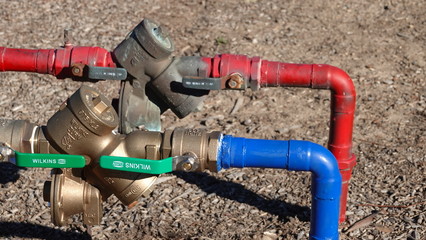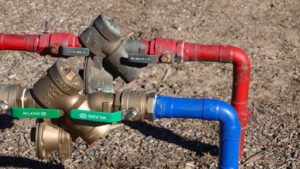
The Importance of Backflow Testing
Backflow testing is a time-consuming task that requires attention to detail. It involves shutting off a water valve, recording test results, and submitting the paperwork to a local water authority.
Backflow testing can prevent dangerous diseases like typhoid and dysentery from spreading in the water supply. It’s a necessary procedure that should be taken seriously by all homeowners. Checkout https://tidalplumbingnyc.com/ for more details.
Backflow testing may seem like a minor item on a homeowner’s to-do list, but it’s essential for keeping your home safe and healthy. Without it, dirty water could backflow into clean pipes, causing waterborne diseases and other problems. This is why every household must keep up with their backflow testing schedule. If you don’t, you could face fines and illnesses down the line.
Backflow tests are done by trained professionals, and they involve a few different steps. The exact process varies wildly depending on the type of preventer that’s installed in your pipes, but there are some general rules that all testers must follow. These steps include flushing the test kit and removing the gauges to make sure they’re free of dirt. A backflow test kit is a tool that generates data that a knowledgeable certified tester can interpret. It’s important to know what the tester is looking for and how to read the results.
Testcocks are important for backflow testing because they allow you to test the pressure on a valve without taking it apart. They are often made of bronze and have a small valve that opens to draw in air. They can also be used as isolation valves for gauges and other small equipment. You can find them at most hardware stores.
A testcock can also help you protect your home from back-siphonage, a phenomenon that occurs when the pressure in your pipes drops. This causes water to flow upwards through the pipes, similar to a straw that you might suck water out of a glass of water with. Backflow testing is the best way to protect against this.
The most common type of backflow prevention assembly is the Reduced Pressure Zone Assembly (RPZA). This device contains two spring-loaded check valves with a differential relief valve between them, two shut-off valves, and four test cocks. It works the same as a DCVA but provides more protection against backflow. This type of assembly is also used in fire protection systems. Its dual-check valves are designed to provide the maximum level of protection.
Shut-off valves
Backflow testing is a vital part of maintaining safe water supplies. It helps prevent wastewater from entering your clean drinking water supply, and it also protects buildings and their inhabitants from damage. Regular maintenance of your backflow prevention system is also a good idea since it can help save you money in the long run. It’s a lot cheaper to spend $80 on a backflow test once a year than to shell out thousands of dollars in repairs down the road.
It’s crucial to know that backflow prevention systems aren’t foolproof. They can still allow contaminated water to reach your home, so it’s important to keep up with the tests. Drinking contaminated water can affect people’s health, and it’s also bad for the environment. It can also cause buildings to fall apart from moisture, so it’s important to test your backflow prevention system regularly.
In some cases, a backflow tester will need to shut off the water in order to perform a test. This will usually happen at the main water meter, and it’s important to know how to do it correctly. If you’re not sure how to do it, consider hiring a professional. This way, you can be assured that the job will be done properly.
Many backflow testers are also starting to use software to simplify their work. This software can automate redundant data entry and even help the tester save time by automatically filling in previous backflow test results. This is a huge step forward in productivity for testers and water purveyors.
While a backflow test is a necessary procedure, it can be frustrating and confusing. There are so many things that can go wrong with the process, and it’s easy to get confused by all the different forms and rules. Some of these forms can be up to 20 pages long, and the form information may conflict with each other. This can lead to a lot of wasted time, and it’s not good for the environment.
It’s best to hire a backflow testing company that can help you with all of your backflow tests. They will be able to test the shut-off valves and ensure that they’re functioning properly. They will also be able to identify any unauthorized connections.
Air gap
Backflow into a public water supply can cause contamination and is therefore a health hazard. In order to protect drinking water supplies, federal and state regulations require that a backflow prevention device be installed to prevent cross-connections. Cross-connections can occur when an auxiliary water system, such as a rainwater tank or cistern, connects directly to the potable water supply. These systems are not always properly installed, so they can be susceptible to backflow. In this case, backflow can siphon contaminants from the auxiliary water system into the potable water supply.
One of the most common ways to avoid this is to install air gaps. This is a very simple method of backflow prevention that is almost impossible to bypass. In fact, the concept of the air gap is similar to computer security, and it can also be applied to backflow testing.
An air gap is simply a space between the flood level of the potable water supply and the drain or sewer point. This creates a space that is too large for dirty sewage to reach your faucet. This space is important because it ensures that your clean drinking water is not contaminated by sewage or other contaminants.
Often, backflow into your house is caused by sewer backups or a loss of pressure in the plumbing system. This can lead to a cross-connection, where non-potable water and potable water are connected. This is a serious health hazard for your family and the local water supply system. It is important to have your home’s plumbing correctly installed and tested regularly.
If you have a backflow problem, you should contact your local backflow testing company for assistance. They will be able to recommend the best solution for you. In some cases, they can even provide the equipment needed for your test.
A backflow assembly is a device that can be used to prevent backflow into a home’s water supply line. It is a small device that is placed in the water line, and it blocks the flow of water in the event of a backflow situation. During backflow testing, the device is checked to ensure it is functioning properly and that no contaminants are entering the water supply. In addition to preventing backflow, the device can also be used to test water pressure.
Pressure gauges
A backflow test kit is a combination of a differential pressure gauge, needle valves, hoses, and a carrying case. It is used for testing DCVA, RPV, and PVB backflow prevention assemblies. Differential pressure gauges are important for backflow testing because they provide accurate readings that can be compared to a reference gauge. They also have a maximum operating pressure pointer and a glycerine-filled diaphragm or bellows that prevent damage from excessive pressure. A differential pressure gauge is the most common type of gauge that is used in backflow testing.
A quality backflow test gauge will have a high-quality construction with an easy-to-read dial face and large numbers. It will also have a lower mount or center-back mount connection with a national pipe thread. Moreover, it should be water-resistant and have a durable carry case to protect the equipment from weather conditions and other hazards. It will also have a high-quality, soft-seated needle valve that is capable of withstanding the test pressure.
The gauges in backflow testing kits are usually calibrated to a traceable NIST standard. This is essential to ensuring that the gauges are performing properly. Often, local administrative authorities require that test gauges be calibrated annually. While this is a necessary maintenance function, it is not a repair function. In order to verify the accuracy of a gauge, it must be compared to a reference gauge in ascending and descending order. The difference between the resulting readings is called hysteresis and is indicative of the gauge’s accuracy.
Gauges can be either mechanical or digital. A mechanical gauge has a Bourdon tube, which moves in response to changes in pressure. This movement is recorded by the gauge’s scale and provides an indication of the pressure within the system. The higher the reading, the more pressure is in the system. In contrast, a digital gauge has a digital display that reads pressure electronically.
During backflow testing, property owners should be aware that their water may be shut off for a few hours. They should make alternative plans for their water usage until the test is complete. They should also inform their neighbors that the water may be turned off for a short period of time. This will help speed up the process and prevent any inconveniences for them.
